Initial Access in 5G
This tutorial will introduce the audience to initial access procedure and downlink synchronization in 5G networks. The initial access incapsulate the following components:
Master Information Block (MIB)
Physical Broadcast Channel (PBCH)
Synchronization Signal Block (SSB):
Primary Synchronization Signal (PSS)
Secondary Synchronization Signal (SSS)
PBCH payload
Demodulation Reference Signal (DMRS) for PBCH
Time Synchronization
Frequency Synchronization
This content covers following topics:
Import Libraries
External Libaries
[1]:
# %matplotlib widget
import matplotlib.pyplot as plt
import os
os.environ["CUDA_VISIBLE_DEVICES"] = "-1"
os.environ['TF_CPP_MIN_LOG_LEVEL'] = '3'
import numpy as np
5G Toolkit Modules
[2]:
import sys
sys.path.append("../../../")
from toolkit5G.SequenceGeneration import PSS, SSS, DMRS
from toolkit5G.PhysicalChannels import PBCH, PBCHDecoder
from toolkit5G.ResourceMapping import SSB_Grid, ResourceMapperSSB
from toolkit5G.ChannelModels import AntennaArrays, SimulationLayout, ParameterGenerator, ChannelGenerator
from toolkit5G.OFDM import OFDMModulator, OFDMDemodulator
from toolkit5G.ChannelProcessing import ApplyChannel, AddNoise
from toolkit5G.MIMOProcessing import AnalogBeamforming, ReceiveCombining
from toolkit5G.ReceiverAlgorithms import ChannelEstimationAndEqualization, ChannelEstimationAndEqualizationPBCH
from toolkit5G.ReceiverAlgorithms import PSSDetection, SSSDetection, DMRSParameterDetection
from toolkit5G.Configurations import TimeFrequency5GParameters, GenerateValidSSBParameters
System Parameters
[3]:
## System Parameters
carrierFrequency = 3.6*10**9 # Carrier frequency 3.6 GHz
scs = 30*(10**3); # Subcarrier spacing for simulation
bandwidthTx = 10*(10**6); # Transmission bandwidth
nSymbolFrame= 140*int(scs/15000); # Number of OFDM symbols per frame (Its a function of subcarrier spacing)
## This class fetches valid set of 5G parameters for the system configurations
tfParams = TimeFrequency5GParameters(bandwidthTx, scs)
tfParams(nSymbolFrame, typeCP = "normal")
nRB = tfParams.numRBs # SSB Grid size (Number of RBs considered for SSB transition)
Neff = tfParams.Neff # Number of resource blocks for Resource Grid ( exclude gaurd band | offsets : BWP)
Nfft = 512 # FFT-size for OFDM
lengthCP = tfParams.lengthCP # CP length
[4]:
## System Parameters
carrierFrequency = 3.6*10**9 # Carrier frequency 3.6 GHz
scs = 30*(10**3); # Subcarrier spacing for simulation
bandwidthTx = 10*(10**6); # Transmission bandwidth
nSymbolFrame= 140*int(scs/15000); # Number of OFDM symbols per frame (Its a function of subcarrier spacing)
## This class fetches valid set of 5G parameters for the system configurations
tfParams = TimeFrequency5GParameters(bandwidthTx, scs)
tfParams(nSymbolFrame, typeCP = "normal")
nRB = tfParams.numRBs # SSB Grid size (Number of RBs considered for SSB transition)
Neff = tfParams.Neff # Number of resource blocks for Resource Grid ( exclude gaurd band | offsets : BWP)
Nfft = 512 # FFT-size for OFDM
lengthCP = tfParams.lengthCP # CP length
#___________________________________________________________________
## Number of batches | Number of Transmitter | Number of Receivers |
## Number of Symbols | Number of Tx-Antennas | Number of Rx-Antennas
numUEs = 1 # Number of UE condsidered for Simulation
Nr_x = 2 # Number of antennas placed Horizontally at Receiver (2D Antenna Panels)
Nr_y = 2 # Number of antennas placed Vertically at Receiver (2D Antenna Panels)
Pr = 2 # Polarization of Receiver antennas
numBSs = 3 # Number of BSs condsidered for Simulation
Nt_x = 8 # Number of antennas placed Horizontally at Transmitter (2D Antenna Panels)
Nt_y = 8 # Number of antennas placed Vertically at Transmitter (2D Antenna Panels)
Pt = 2 # Polarization of Transmitter antennas
nBatch = 1 # Number of Batches considerd for Simulations (Similar to Monte-carlo)
PBCH Information
PBCH information consists of MIB and Additional Timing Information (ATI)
Parameters |
Defining |
MIB |
ATI |
|---|---|---|---|
systemFrameNumber |
SFN Consists of 10 Bits and the 6 most significant bits (MSB) of the 10-bit System Frame Number (SFN) are defined in MIB. |
6 |
4 |
subCarrierSpacingCommon |
subcarrier spacing for SIB1, Msg2, Msg4 for initial access, paging, and broadcast SI-messages. |
1 |
0 |
ssbSubCarrierOffset |
Frequency domain offset between SSB and the overall resource block grid in number of subcarriers |
4-5 |
0 |
DMRSTypeAPosition |
Indicates the position of (first) DM-RS for downlink and uplink when using ‘Mapping Type A’ |
1 |
0 |
controlResourceSet0 |
Determines a common ControlResourceSet (CORESET), a common search space and necessary PDCCH parameters. |
4 |
0 |
searchSpace0 |
Indicates that SIB1 is present, the field pdcch-ConfigSIB1 indicates the frequency positions where the UE may find SS/PBCH block with SIB1. |
4 |
0 |
cellBarred |
Indicates whether the current cell is barred. This field is ignored by IAB-MT. In LTE this information was provided in SIB1 |
1 |
0 |
intraFrequencyReselection |
Controls cell selection/reselection to intra-frequency cells when the highest ranked cell is barred, or treated as barred by the UE. |
1 |
0 |
SSB Index |
Indicates the index of the SSB in the group of \(\text{L}_\text{max}\) SSBs transmitted in a half frame. |
0-3 |
0 |
Spare Bit |
Unused |
1 |
0 |
[5]:
lamda = 3e8/carrierFrequency;
nSCSOffset = 1
ssbParameters = GenerateValidSSBParameters(carrierFrequency, nSCSOffset)
systemFrameNumber = ssbParameters.systemFrameNumber
subCarrierSpacingCommon = ssbParameters.subCarrierSpacingCommon
ssbSubCarrierOffset = ssbParameters.ssbSubCarrierOffset
DMRSTypeAPosition = ssbParameters.DMRSTypeAPosition
controlResourceSet0 = ssbParameters.controlResourceSet0
searchSpace0 = ssbParameters.searchSpace0
isPairedBand = ssbParameters.isPairedBand
nSCSOffset = ssbParameters.nSCSOffset
choiceBit = ssbParameters.choiceBit
ssbType = ssbParameters.ssbType
nssbCandidatesInHrf = ssbParameters.nssbCandidatesInHrf
ssbIndex = ssbParameters.ssbIndex
hrfBit = ssbParameters.hrfBit
cellBarred = ssbParameters.cellBarred
intraFrequencyReselection = ssbParameters.intraFrequencyReselection
withSharedSpectrumChannelAccess = ssbParameters.withSharedSpectrumChannelAccess
nFrames = 0.5
Nsc_ssb = 240
Nsymb_ssb = 4
#_______________________________________
Transmission-side Processing
Generate the PSS
Generate the SSS
Generate the PBCH
Generate the DMRS-PBCH
Load the above information into Synchronization Signal Block (SSB)
Insert the SSB into Resource Grid
Load Resource Grid into Transmission Grid
OFDM Modulation
Analog Beamforming
Transmitter side implementation of SSB |
Generate Primary Synchronization Sequence (PSS)
Inputs: Cell ID-2 (\(\text{N}_\text{ID}^\text{2}\)):
N_ID2Object for generating PSS sequence:
pssObjectPSS Sequence:
pssSequence
[6]:
N_ID2 = np.random.randint(3)
# Generate PSS sequence
pssObject = PSS(N_ID2);
pssSequence = pssObject()
Generate Secondary Synchronization Sequence (SSS)
Inputs:
Cell ID-1 (\(\text{N}_\text{ID}^\text{1}\)):
N_ID1Cell ID-2 (\(\text{N}_\text{ID}^\text{2}\)):
N_ID2
Object for generating SSS sequence:
sssObjectPSS Sequence:
sssSequence
[7]:
N_ID1 = np.random.randint(336)
N_ID = 3*N_ID1 + N_ID2
# Generate SSS sequence
sssObject = SSS(N_ID1, N_ID2);
sssSequence = sssObject()
Generate Demodulation Reference Sequence (DMRS)
Inputs:
Cell ID (\(\text{N}_\text{ID} = 3 \times \text{N}_\text{ID}^\text{1} + \text{N}_\text{ID}^\text{2}\)):
N_IDSSB Index (\(\text{i}_\text{SSB}\)):
ssbIndexMaximum SSBs in a half frame (\(\text{L}_\text{max}\)):
nssbCandidatesInHrfHalf frame bit (\(\text{n}_\text{HF}\)):
hrfBit
Object for generating DMRS sequence:
dmrsObjectDMRS Sequence:
dmrsSequence
[8]:
# Generate DMRS sequence
dmrsLen = 144;
dmrsObject = DMRS("PBCH", N_ID, ssbIndex, nssbCandidatesInHrf, hrfBit)
# dmrsSeq = dmrs.getSequence("tensorflow")
dmrsSequence = dmrsObject(dmrsLen)
Generate the PBCH Payload
Inputs:
Carrier frequency (\(f_c\)):
carrierFrequencyChoice bit:
choiceBitSubcarrier spacing common (\(\Delta f\)):
subCarrierSpacingCommonDMRS TypeA-Position:
DMRSTypeAPositionControl ResourceSet0:
controlResourceSet0Search Space0:
searchSpace0cell Barred flag:
cellBarredintraFrequencyReselection:
intraFrequencyReselectionSystem Frame Number:
systemFrameNumberssbSubCarrierOffset (\(k_{ssb}\)):
ssbSubCarrierOffsetHalf frame bit (\(\text{n}_\text{HF}\)):
hrfBitSSB Index (\(\text{i}_\text{SSB}\)):
ssbIndexCell ID (\(\text{N}_\text{ID}\)):
N_IDMaximum SSBs in a half frame (\(\text{L}_\text{max}\)):
nssbCandidatesInHrf
Object for generating PBCH symbols:
pbchObjectPBCH symbols:
pbchSymbols
Implementation of PBCH is detailed below:
[9]:
# Generate PBCH symbols
pbchObject = PBCH(carrierFrequency, choiceBit, subCarrierSpacingCommon, DMRSTypeAPosition,
controlResourceSet0, searchSpace0, cellBarred, intraFrequencyReselection,
systemFrameNumber, ssbSubCarrierOffset, hrfBit, ssbIndex, N_ID,
nssbCandidatesInHrf)
pbchSymbols = pbchObject()
Constellation Diagram: Tx
[10]:
fig, ax = plt.subplots()
ax.scatter(np.real(pbchSymbols), np.imag(pbchSymbols))
ax.grid()
ax.axhline(y=0, ls=":", c="k")
ax.axvline(x=0, ls=":", c="k")
ax.set_xlabel("Real {x}")
ax.set_ylabel("Imag {x}")
ax.set_title("Constellation Diagram: QPSK")
plt.show()
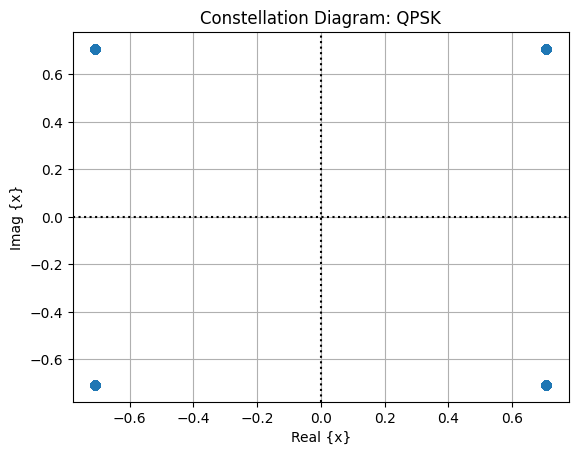
Construct SSB Grid
Parameters:
Cell ID (\(\text{N}_\text{ID}\)):
N_ID
Object for generating PBCH symbols:
ssbObjectInputs
pssSequence,
sssSequence,
dmrsSequence,
pbchSymbols
PBCH symbols:
ssb
[11]:
ssbObject = SSB_Grid(N_ID, True)
ssb = ssbObject(pssSequence, sssSequence, dmrsSequence, pbchSymbols)
fig = ssbObject.displayGrid(option=1)
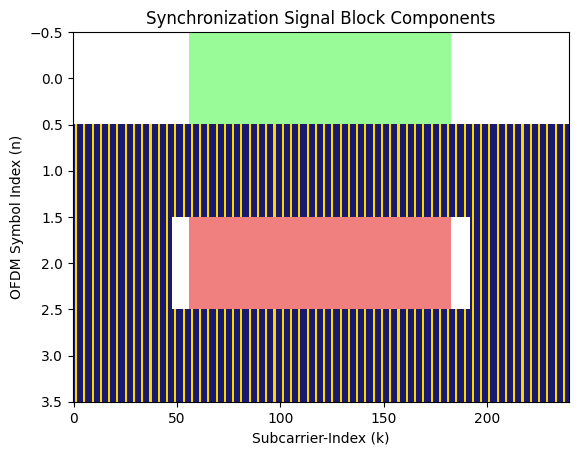
Mapping SSB to Transmission Grid for ODFM
[12]:
## Loading SSB to SSB Grid
#####################################
# ssbPositionInBurst = np.ones(nssbCandidatesInHrf, dtype=int)
ssbPositionInBurst = np.zeros(nssbCandidatesInHrf, dtype=int)
ssbPositionInBurst[0] = 1
# ssbRGobject = ResourceMapperSSB(ssbType=ssbType, carrierFrequency = carrierFrequency, N_RB=nRB,
# kssb=int(ssbSubCarrierOffset), offsetToPointA = int(nRB*0.5-10),
# scsCarrier = subCarrierSpacingCommon,
# ssbPositionInBurst = ssbPositionInBurst, ssbPeriodicity = None, nHF=None,
# nFrames = 0.1*nFrames, isPairedBand = isPairedBand,
# withSharedSpectrumChannelAccess = withSharedSpectrumChannelAccess)
# ssbGrid = ssbRGobject(ssb[0])
ssbRGobject = ResourceMapperSSB(ssbType, carrierFrequency, isPairedBand, withSharedSpectrumChannelAccess)
ssbGrid = ssbRGobject(ssb[0], ssbPositionInBurst, offsetInSubcarriers = ssbSubCarrierOffset[0],
offsetInRBs = 0, numRBs = nRB)[0:14]
## Loading SSB to Resource Grid
numofGuardCarriers = (int((Nfft - Neff)/2), int((Nfft - Neff)/2))
offsetToPointA = 0
firstSCIndex = int(numofGuardCarriers[0] + offsetToPointA)
numOFDMSymbols = ssbGrid.shape[0]
X = np.zeros((numOFDMSymbols, Nfft), dtype= np.complex64)
X[:, firstSCIndex:firstSCIndex+ssbGrid.shape[-1]] = ssbGrid
# Plot Resource Grid
#################################################################
fig, ax = plt.subplots()
plt.imshow(np.abs(X), cmap = 'hot', interpolation='nearest', aspect = "auto")
ax = plt.gca();
ax.grid(color='c', linestyle='-', linewidth=1)
# Gridlines based on minor ticks
plt.show()
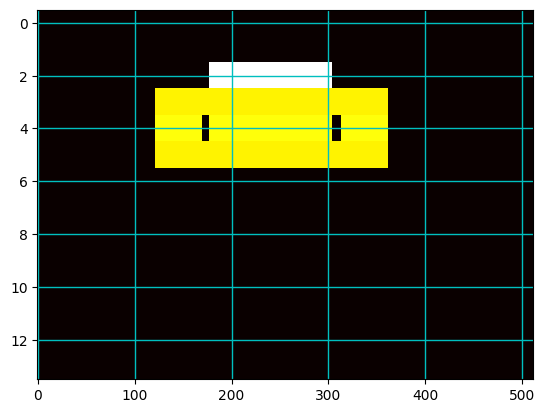
[13]:
ssbGrid.shape
[13]:
(14, 288)
OFDM-Modulator
OFDM Modulator process the transmission grid column by column and performs following operations on each column: - Fetch a column of the transmission grid - Size of each column is \(\text{N}_\text{FFT}\). - IFFT Shift - IFFT Transform - Add cyclic prefix
[14]:
## OFDM Modulation at Transmitter
#####################################
modulator = OFDMModulator(lengthCP[1])
x_time = modulator(X)[np.newaxis, np.newaxis, np.newaxis, ...]
#______________________________________________________
Analog Beamforming
Input
Beamforming Direction (\(\theta, \phi\)):
bfAngleTransmit Power, \(P_t\) (dBm):
Pt_dBmTransmit Signal, \(x(t)\):
x_time
Analog Beamformer Object:
aBFOutput:
Beamformed Signal:
x_Beam
[15]:
## Analog Beamforming at Transmitter
#####################################
# Beamforming Parameters
# Number of antennas for Beamforming
# Beamforming angles
# Total Transmit Power
Pt_dBm = 43; # dBm
Pt_a = 10**((Pt_dBm-30)/10)
bfAngle= np.array([0, 0])
# nSymbforScheduling = startOFDMSymbolIndices[-1]*Nfft;
nSymbforScheduling = x_time.shape[-1]
x_Beam = np.zeros([x_time.shape[0], x_time.shape[1], Nt_x*Nt_y*Pt,
nSymbforScheduling], dtype = np.complex64)
isCustomBeamformer = False
aBF = AnalogBeamforming(carrierFrequency, isCustomBeamformer)
for nbatch in range(x_time.shape[0]):
for ntx in range(x_time.shape[1]):
x_Beam[nbatch, ntx, :, :] = aBF(x_time[nbatch][ntx][:,:], Pt_dBm, bfAngle,
np.array([lamda/2, lamda/2]), np.array([Nt_x, Nt_y, Pt]))
Channel Generation
[16]:
propTerrain = "UMa" # Propagation Scenario or Terrain for BS-UE links
print()
print("*****************************************************")
print(" Terrain: "+str(propTerrain))
print(" Number of UEs: "+str(numUEs))
print(" Number of BSs: "+str(numBSs))
print("*****************************************************")
print()
# Antenna Array at UE side
# assuming antenna element type to be "OMNI"
# with 2 panel and 2 single polarized antenna element per panel.
ueAntArray = AntennaArrays(antennaType = "OMNI", centerFrequency = carrierFrequency,
arrayStructure = np.array([1, 1, Nr_x, Nr_y, Pr]))
ueAntArray()
# # Radiation Pattern of Rx antenna element
# ueAntArray.displayAntennaRadiationPattern()
# Antenna Array at BS side
# assuming antenna element type to be "3GPP_38.901", a parabolic antenna
# with 4 panel and 4 single polarized antenna element per panel.
bsAntArray = AntennaArrays(antennaType = "3GPP_38.901", centerFrequency = carrierFrequency, arrayStructure = np.array([1, 1, Nt_x, Nt_y, Pt]))
bsAntArray()
# # Radiation Pattern of Tx antenna element
# bsAntArray[0].displayAntennaRadiationPattern()
# Layout Parameters
isd = 200 # inter site distance
minDist = 10 # min distance between each UE and BS
ueHt = 1.5 # UE height
bsHt = 25 # BS height
bslayoutType = "Hexagonal" # BS layout type
ueDropType = "Hexagonal" # UE drop type
htDist = "equal" # UE height distribution
ueDist = "equal" # UE Distribution per site
nSectorsPerSite = 3 # number of sectors per site
maxNumFloors = 1 # Max number of floors in an indoor object
minNumFloors = 1 # Min number of floors in an indoor object
heightOfRoom = 3 # height of room or ceiling in meters
indoorUEfract = 0.5 # Fraction of UEs located indoor
lengthOfIndoorObject = 3 # length of indoor object typically having rectangular geometry
widthOfIndoorObject = 3 # width of indoor object
# forceLOS = True # boolen flag if true forces every link to be in LOS state
forceLOS = False # boolen flag if true forces every link to be in LOS state
# simulation layout object
simLayoutObj = SimulationLayout(numOfBS = numBSs,
numOfUE = numUEs,
heightOfBS = bsHt,
heightOfUE = ueHt,
ISD = isd,
layoutType = bslayoutType,
ueDropMethod = ueDropType,
UEdistibution = ueDist,
UEheightDistribution = htDist,
numOfSectorsPerSite = nSectorsPerSite,
ueRoute = None)
simLayoutObj(terrain = propTerrain,
carrierFreq = carrierFrequency,
ueAntennaArray = ueAntArray,
bsAntennaArray = bsAntArray,
indoorUEfraction = indoorUEfract,
lengthOfIndoorObject = lengthOfIndoorObject,
widthOfIndoorObject = widthOfIndoorObject,
forceLOS = forceLOS)
# displaying the topology of simulation layout
fig, ax = simLayoutObj.display2DTopology()
paramGen = simLayoutObj.getParameterGenerator()
# paramGen.displayClusters((0,0,0), rayIndex = 0)
channel = paramGen.getChannel()
Hf = channel.ofdm(scs, Nfft)
htime = np.fft.ifft(Hf, norm="ortho", n=Nfft, axis = -3)
Nt = bsAntArray.numAntennas # Number of BS Antennas
Nr = ueAntArray.numAntennas
print(" Number of BSs: "+str(numBSs))
print(" Shape of Channel: "+str(htime.shape))
print("*****************************************************")
print()
*****************************************************
Terrain: UMa
Number of UEs: 1
Number of BSs: 3
*****************************************************
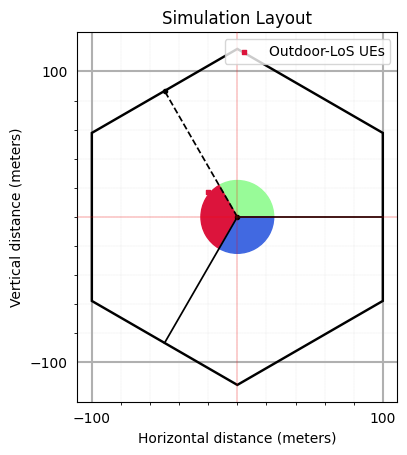
Number of BSs: 3
Shape of Channel: (1, 1, 3, 1, 512, 8, 128)
*****************************************************
[17]:
bsAntArray.displayAntennaRadiationPattern()
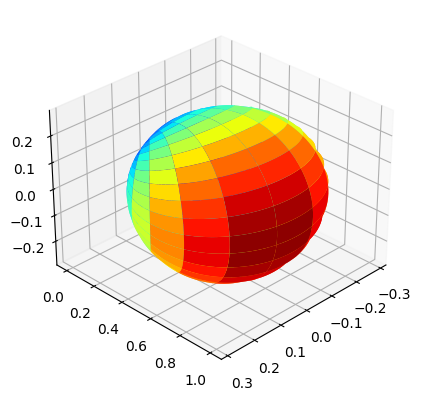
[17]:
(<Figure size 960x480 with 1 Axes>, <Axes3D: >)
[18]:
ueAntArray.displayAntennaRadiationPattern()
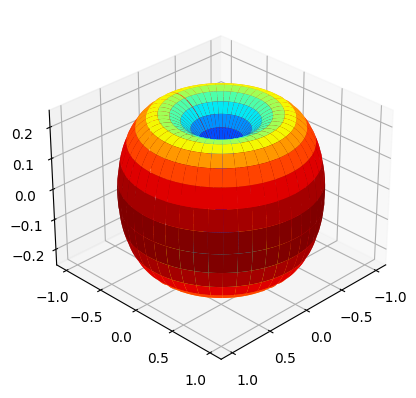
[18]:
(<Figure size 960x480 with 1 Axes>, <Axes3D: >)
Pass Tx signal through Wireless Channel
[19]:
# Channel Dimensions: numBatches, numFrequencies, numSymbols(numSnapshots), numBSs, numUEs, numSamples/numFFTpoints, numRxAntennas, numTxAntennas
# Tx-Grid Dimensions: numBatches, numFrequencies, numSymbols(numSnapshots), numBSs, numSamples/numFFTpoints, numTxAntennas
# Rx-Grid Dimensions: numBatches, numFrequencies, numSymbols(numSnapshots), -- numUEs, numSamples/numFFTpoints, numRxAntennas
ptc = ApplyChannel(isFrequencyDomain = False, enableInterTxInterference = True, memoryConsumptionLevel = 4)
y = ptc(htime[np.newaxis], x_Beam.transpose(0,1,3,2)[np.newaxis, np.newaxis])
# returns y of shape: numBatch x numFreq x numSnapshots x numUEs x numSamples x numRxAntennas
Noise addition at receiver
[21]:
## Noise added by the Receiver
k_Bolt = 1.380649*(10**(-23));
Temp = 300;
Bandwidth = Nsc_ssb*scs
n0 = k_Bolt*Temp*Bandwidth
kppm = 0
fCFO = kppm*(np.random.rand()-0.5)*carrierFrequency*(10**(-6)); # fCFO = CFO*subcarrierSpacing
CFO = (fCFO/scs)/Nfft
yn = AddNoise(True)(y, n0, CFO)
SSB Receiver Side
Receiver side implements the following procedures for downlink synchronization: - Receiver Combining - Time Synchronization. - Raster Search - Finding OFDM symbol boundry - \(\text{N}_\text{ID}^\text{2}\) detection. - Resource Grid reconstruction - Extract SSB Grid - SSS Detection - \(\text{N}_\text{ID}^\text{1}\) detection. - DMRS Parameter estimation - Estimates following parameters - Half frame Index - SSB Index (lower 3 values) - Symbol Equalization - Estimate PBCH Symbols - PBCH Decoding - Decode MIB parameters - Decode ATI Parameters
The detail procedure is shown below:
Receiver side implementation of SSB |
Receiver combining
[22]:
## Receiver combiner Object
# angles = np.array([[0, -70]])
angles = np.zeros([90,2])
angles[:,1] = np.linspace(0,360, 90)
spacing = np.array([lamda/2, lamda/2])
rxArray = np.array([Nr_x, Nr_y, Pr])
rxCombining = ReceiveCombining(combinerType = "dft", numDFTBeams = 16, output = "best")
r = rxCombining(yn)
[23]:
r.shape, yn[:,:,:,[0]].shape
[23]:
((1, 1, 1, 1, 8183), (1, 1, 1, 1, 8183, 8))
PSS Detection: largest peak
[24]:
## PSS Detection: Based on time domain PSS Correlation
# pssPeakIndices, pssCorrelation, rN_ID2 = pssDetection(r, Nfft, lengthCP = lengthCP[1],
# N_ID2 = None, freqOffset = ssboffset,
# height = 0.75, prominence = 0.65, width=10)
## PSS Detection: Based on time domain PSS Correlation
# pssDetection = PSSDetection("correlation", "threshold")
pssDetection = PSSDetection("largestPeak")
ssboffset = int((Nfft-Neff)/2+ssbRGobject.startingSubcarrierIndices)
pssPeakIndices, pssCorrelation, rN_ID2, freqOffset = pssDetection(r.flatten(), Nfft, lengthCP = lengthCP[1],
nID2=None, freqOffset = ssboffset)
**(rasterOffset, PSS-ID) (122, 0)
**(rasterOffset, PSS-ID) (122, 1)
**(rasterOffset, PSS-ID) (122, 2)
Largest peak
[25]:
## PSS Detection Plot
#################################################################
fig, ax = plt.subplots()
# single line
plt.plot(pssCorrelation)
plt.vlines(x = pssPeakIndices, ymin = 0*pssCorrelation[pssPeakIndices],
ymax = pssCorrelation[pssPeakIndices], colors = 'purple')
plt.ylim([0,np.max(pssCorrelation)*1.1])
plt.show()
#________________________________________________________________

OFDM Demodulation: Resource Grid reconstruction
OFDM Demodulator process a block of data and performs following operations on each column: - Fetch a (\(\text{N}_\text{FFT} + \text{L}_\text{CP}\)) samples from the received sequence. - Remove the cycle prefix \(\text{L}_\text{CP}\) samples - Perform FFT Transform on remaining \(\text{N}_\text{FFT}\) samples - Insert these samples into the columns of a grid.
[26]:
## OFDM Demodulator Object
ofdmDemodulator = OFDMDemodulator(Nfft, lengthCP[1])
pssStartIndex = pssPeakIndices
# pssStartIndex = pssPeakIndices[0][0]
rxGrid = ofdmDemodulator(r[...,pssStartIndex:(pssStartIndex+4*(Nfft+lengthCP[1]))])[0,0,0,0]
[27]:
rxGrid.shape
[27]:
(4, 512)
SSB Extaction from Resource Grid
[28]:
ssbSCSoffset = int((Nfft-Neff)/2+ssbRGobject.startingSubcarrierIndices)
ssbEstimate = rxGrid[...,ssbSCSoffset:(ssbSCSoffset+240)]
Comparing Transmitted and Received SSB Grid
[29]:
# Plot SSB
fig, ax = plt.subplots(1,2)
ax[0].imshow(np.abs(ssbEstimate), cmap = 'hot', interpolation='nearest', aspect = "auto")
ax[0].grid(color='c', linestyle='-', linewidth=1)
ax[1].imshow(np.abs(ssb[0]), cmap = 'hot', interpolation='nearest', aspect = "auto")
ax[1].grid(color='c', linestyle='-', linewidth=1)
plt.show()
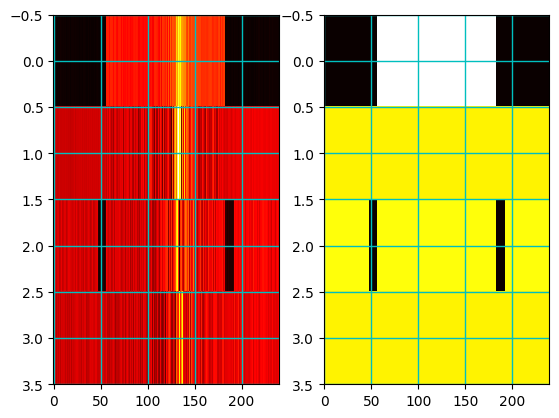
Spectrum Analysis
[30]:
ssbRGobject.firstSymbolIndices
[30]:
array([ 2, 8, 16, 22, 30, 36, 44, 50])
[31]:
# Plot SSB
fig, ax = plt.subplots(1,2)
ax[0].plot(np.arange(rxGrid.shape[-1])*subCarrierSpacingCommon + carrierFrequency, np.abs(rxGrid[0]), lw = 3)
ax[0].grid(color='k', linestyle='-', linewidth=1)
ax[0].set_xlabel("Frequency")
ax[0].set_ylabel("Power")
ax[0].set_title("Spectrum of received Signal")
ax[1].plot(np.arange(X.shape[-1])*subCarrierSpacingCommon + carrierFrequency, np.abs(X[ssbRGobject.firstSymbolIndices[0]]), lw = 6)
ax[1].grid(color='k', linestyle='-', linewidth=1)
ax[1].set_xlabel("Frequency")
ax[1].set_ylabel("Power")
ax[1].set_title("Spectrum of tranmitted Signal")
plt.show()

(SSS Detection: PSS channel assisted) + Cell-ID estimation
[32]:
sssDetection = SSSDetection(method="channelAssisted", nID2=rN_ID2)
rN_ID1 = sssDetection(ssbEstimate)
rN_ID = 3*rN_ID1 + rN_ID2
DMRS Parameters Detection + DMRS Sequence Generation
[33]:
## Generate SSB object to get DMRS and PBCH Indices
rxSSBobject = SSB_Grid(rN_ID)
rxDMRSIndices = rxSSBobject.dmrsIndices
## Generate DMRS sequence
dmrsDetection = DMRSParameterDetection(int(rN_ID), nssbCandidatesInHrf)
rssbIndex, rHrfBit = dmrsDetection(ssbEstimate)
rxDMRSobject = DMRS("PBCH", int(rN_ID), int(rssbIndex), nssbCandidatesInHrf, rHrfBit)
rxDMRSseq = rxDMRSobject(dmrsLen)
Channel Estimation and PBCH Symbol Equalization
The following steps are performed: - Channel Estimation - Symbol Equalization
The details of the implementation is as follow:
Parameters |
Values |
|---|---|
Channel Estimator |
Zeros forcing |
Channel Interpolation |
Nearest Neighbour |
Symbol Equalization |
Minimum mean square error |
[34]:
## Estimating the channel at DMRS (t-f) location, interpolting for data (t-f) location and equalizing the symbols
## Object for Channel Estimation
chanEst = ChannelEstimationAndEqualizationPBCH(estimatorType = "ZF", interpolatorType = "NN", isUEmobile=False)
rxPBCHIndices = rxSSBobject.pbchIndices
pbchEstimate = chanEst(ssbEstimate, rxDMRSseq[0], rN_ID)
[35]:
ssbEstimate.shape
[35]:
(4, 240)
Constellation Diagram: Rx
[36]:
fig, ax = plt.subplots()
ax.scatter(np.real(pbchEstimate), np.imag(pbchEstimate))
ax.scatter(np.real(pbchSymbols), np.imag(pbchSymbols), s=48)
ax.grid()
ax.axhline(y=0, ls=":", c="k")
ax.axvline(x=0, ls=":", c="k")
ax.set_xlim([-2,2])
ax.set_ylim([-2,2])
ax.set_xlabel("Real {x}")
ax.set_ylabel("Imag {x}")
ax.set_title("Constellation Diagram: QPSK")
plt.show()
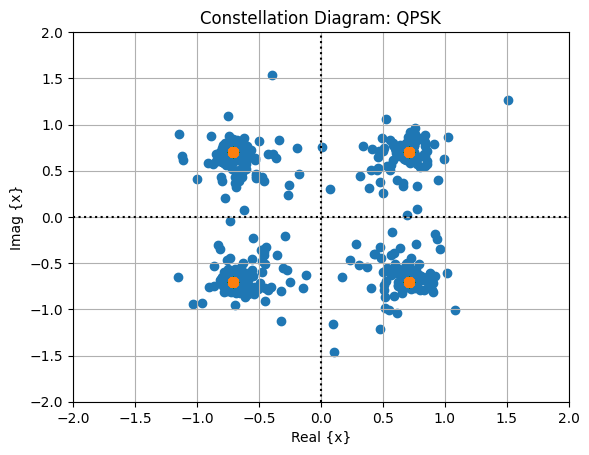
PBCH Decoding
PBCH decoder extract the MIB and ATI payload bits from the estimated/equalized symbols.
Implementation of PBCH is detailed below:
[37]:
## PBCH Chain for Decoding information
polarDecoder = "SCL"
symbolDemapper = "maxlog"
# extractMIBinfo = False
extractMIBinfo = True
# carrierFreq, cellID, nssbCandidatesInHrf, ssbIndex, polarDecType, symbolDemapperType
pbchDecoder = PBCHDecoder(carrierFrequency, int(rN_ID), nssbCandidatesInHrf, rssbIndex, polarDecoder, symbolDemapper)
rxMIB, check = pbchDecoder(pbchEstimate, Pt_a/n0, extractMIBinfo)
/home/tenet/Startup/Packages/5G_Toolkit/version14/Tutorials/Simulations/Tutorial-5 [SSB]/../../../toolkit5G/ChannelCoder/PolarCoder/polarDecoder.py:494: UserWarning: Required ressource allocation is large for the selected blocklength. Consider option `cpu_only=True`.
warnings.warn("Required ressource allocation is large " \
[38]:
if(np.all(check)):
print("[Hurray]: CRC-check passed!")
else:
print("[Ohh]: CRC-check failed!")
[Hurray]: CRC-check passed!
Information Aggregation
[39]:
pbchDecoder.mibRx.displayParameters(0)
Carrier Frequency: 3600000000.0
ChoiceBit: 0
nSsbCandidatesInHrf: 8
subCarrierSpacingCommon:30000
DMRSTypeAPosition: typeB
controlResourceSet0: 11
searchSpace0: 2
cellBarred: notBarred
intraFreqReselection: notAllowed
systemFrameNumber: 470
ssbSubCarrierOffset: 10
HRFBit: 1
iSSBindex: 0
[40]:
pbchObject.mib.displayParameters(0)
Carrier Frequency: 3600000000.0
ChoiceBit: 0
nSsbCandidatesInHrf: 8
subCarrierSpacingCommon:30000
DMRSTypeAPosition: typeB
controlResourceSet0: 11
searchSpace0: 2
cellBarred: notBarred
intraFreqReselection: notAllowed
systemFrameNumber: 470
ssbSubCarrierOffset: 10
HRFBit: 1
iSSBindex: 0
Performance Evaluations: BER + Cell-IDs + DMRS Parameter Detection
Cell-IDs Detection
[41]:
if (rN_ID == N_ID):
print("[Success]: Cell-IDs correctly detected!")
else:
if (rN_ID1 != N_ID1 and rN_ID2 != N_ID2):
print("[Failed]: Receiver couldn't detect the Cell-ID1 and cell-ID2 correctly!")
elif(rN_ID1 != N_ID1):
print("[Failed]: Receiver couldn't detect the Cell-ID1 correctly!")
else:
print("[Failed]: Receiver couldn't detect the cell-ID2 correctly!")
[Success]: Cell-IDs correctly detected!
[42]:
rN_ID1, N_ID1
[42]:
(8, 8)
DMRS Parameter Detection
[43]:
if (rssbIndex == ssbIndex[0]):
print("[Success]: DMRS parameters correctly detected!")
else:
print("[Failed]: Receiver couldn't detect the ssbIndex correctly!")
[Success]: DMRS parameters correctly detected!
BER computation
[44]:
## Computing BER: Coded and Uncoded
uncodedBER = np.zeros((numUEs, nBatch))
codedBER = np.zeros((numUEs, nBatch))
bitEst = pbchDecoder.llr.copy()
bitEst[pbchDecoder.llr > 0] = 1
bitEst[pbchDecoder.llr < 0] = 0
uncodedBER = np.mean(np.abs(bitEst - pbchObject.scr2bits[0]))
codedBER = np.mean(np.abs(pbchDecoder.pbchResequenceBits - pbchObject.payloadMIB[0]))
print(" (uncoded-BER, codedBER): "+str((uncodedBER, codedBER)))
(uncoded-BER, codedBER): (0.004629629629629629, 0.0)
[ ]:
[ ]: